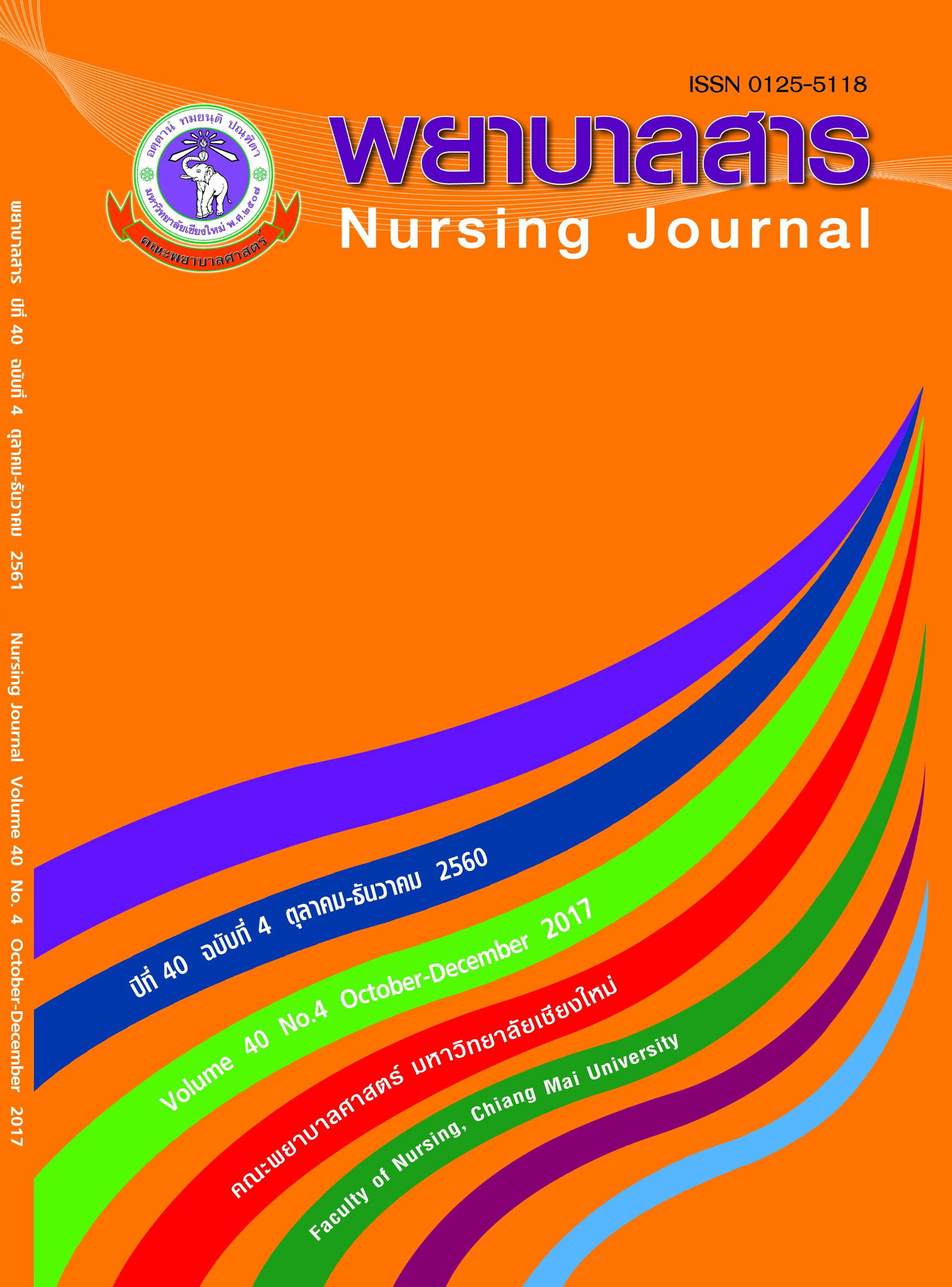Factors Related to Readiness for Hospital Discharge Among Caregivers of Older Patients with Stroke
Keywords:
caregivers of older patients with stroke, readiness for hospital discharge caregiver factors, patient factors and nursing therapeutic factors.Abstract
Caregivers of older patients who have had a stroke take primary responsibility for caring of patients at home. If caregivers are ready to care for patients after discharge, the quality of care will be improved. This descriptive correlational research aimed to describe the relationship between readiness for hospital discharge and the related factors consisting of caregiver factors, patient factors and nursing therapeutic factors. Purposive sampling was used to recruit 88 caregivers of older patients with stroke, admitted at Maharaj Nakorn Chiang Mai Hospital and Nakornping Chiang Mai Hospital from October 2015 to January of 2016. The instruments used in this study were Readiness for Hospital Discharge Scale, Quality of Discharge Teaching Scale and Care Coordination Scale. Data were analyzed using descriptive statistics, Point biserial correlation coefficient, Pearson product moment correlation coefficient and Spearman rank correlation.
The results are revealed as follows:
- 1. The overall readiness for hospital discharge ( =201.70, S.D.=27.64) and dimensions such as physical and emotional status, knowledge, coping ability and expected support as perceived by caregivers of older patients with stroke were at a high level;
- 2. The overall quality of discharge teaching ( =140.28, S.D.=29.13) and dimensionssuch as content and teaching method as perceived by caregivers of older patients with stroke were at a high level;
- 3. Care coordination before discharge as perceived by caregivers of older patients with stroke was at a high level ( =111.05, S.D.=15.39);
- 4. Age, gender and living arrangement of caregivers, prior hospitalization experience of the same condition and length of hospital stay of older patients with stroke were not associated with readiness for hospital discharge among caregivers of older patients with stroke.
- 5. The quality of discharge teaching and care coordination had a positive relationship with readiness for hospital discharge among caregivers of older patients with stroke at a statistical significance level of <.01.
The results of this study provide baseline information for development of discharge planning of older patients with stroke by preparing caregivers using discharge teaching and care coordination.
References
บรรณฑวรรณ หิรัญเคราะห์, สุพัตรา อังศุโรจน์กุล, พรพชร กิตติเพ็ญกุล และลัดดา ลาภศิริอนันต์กุล. (2554). คู่มือการฟื้นฟูสมรรถภาพผู้ป่วยโรคหลอดเลือดสมองสำหรับญาติที่ดูแลผู้ป่วยที่บ้าน. กรุงเทพฯ: สำนักงานกองทุนสนับสนุนการสร้างเสริมสุขภาพ.
ปิยภัทร พัชราวิวัฒน์พงษ์. (2550). การกลับบ้านและการไปมีส่วนร่วมของสังคม. ใน กิ่งแก้ว ปาจรีย์ (บรรณาธิการ), การฟื้นฟูสมรรถภาพผู้ป่วยโรคหลอดเลือดสมอง (หน้า 281-294). กรุงเทพฯ: หจก.เอ็น.พี.เพรส
ภัทรา วัฒนพันธุ์. (2555). คู่มือการจัดการระบบบริการโรคหลอดเลือดสมองครบวงจร. ในสมศักดิ์ เทียม เก่า, กาญจนศรี สิงห์ภู่, กรรณิการ์ คงบุญเกียรติ และพัชรินทร์ อ้วนไตร (บรรณาธิการ), การจัดการ ฝ่ายฟื้นฟูสุขภาพ. (พิมพ์ครั้งที่ 1, หน้า 40-45). ขอนแก่น: โรงพิมพ์คลังนานาวิทยา.
ลัฆวี ปิยะบัณฑิตกุล. (2555). เจาะลึกปัญหาเพื่อคุณภาพชีวิตผู้ป่วยโรคหลอดเลือดสมองในชุมชน. วารสารสมาคมพยาบาลฯ สาขาภาคตะวันออกเฉียงเหนือ, 30, 6-14
ศิริรัตน์ ปานอุทัย. (2557 ก). แบบประเมินความพร้อมในการจำหน่ายก่อนออกจากโรงพยาบาล ฉบับบิดา-มารดา ฉบับภาษาไทย. คณะพยาบาลศาสตร์ มหาวิทยาลัยเชียงใหม่.
ศิริรัตน์ ปานอุทัย. (2557 ข). แบบประเมินคุณภาพการสอนก่อนจำหน่ายจากโรงพยาบาล ฉบับบิดา-มารดา ฉบับภาษาไทย. คณะพยาบาลศาสตร์ มหาวิทยาลัยเชียงใหม่.
สิรัชชา จิรจารุภัทร. (2551). การศึกษาการดูแลผู้ป่วยโรคหลอดเลือดสมองที่บ้านเพื่อป้องกันการเกิด ภาวะแทรกซ้อนโดยเน้นครอบครัวเป็นศูนย์กลาง. วิทยานิพนธ์พยาบาลศาสตรมหาบัณฑิต, มหาวิทยาลัยหัวเฉียวเฉลิมพระเกียรติ.
สุภา สุทัศนะจินดา. (2555). คู่มือการจัดการระบบบริการโรคหลอดเลือดสมองครบวงจร. ใน สมศักดิ์ เทียมเก่า, กาญจนศรี สิงห์ภู่, กรรณิการ์ คงบุญเกียรติ และพัชรินทร์ อ้วนไตร (บรรณาธิการ), การ พัฒนาบุคลากรเพื่อรองรับการบริการโรคหลอดเลือดสมอง. (พิมพ์ครั้งที่ 1, หน้า 268-272). ขอนแก่น: โรงพิมพ์คลังนานาวิทยา.
แสงเดือน กันทะขู้, ดวงรัตน์ วัฒนกิจไกรเลิศ, คนึงนิจ พงศ์ถาวรกมล, ฉัตรกนก ทุมวิภาต. (2552). ปัจจัย ที่มีอิทธิพลต่อความพร้อมก่อนจำหน่ายออกจากโรงพยาบาลในผู้ป่วยกล้ามเนื้อหัวใจตายเฉียบพลัน . Journal of Nursing Science, 21(2), 83-91.
สำนักนโยบายและยุทธศาสตร์ สำนักงานปลัดกระทรวงสาธารณสุข. (2555). “รายงานสถิติผู้ป่วยโรค หลอดเลือดสมอง”. สืบค้นจาก http://bps.ops.moph.go.th/Healthinformation/ill55/ill- full2555.pdf
Anderson, C. S., Linto, J., & Stewart-Wynne, E. G. (1995). A population-based assessment of the impact and burden of caregiving for long-term stroke survivors. Stroke, 26(5), 843- 849.
Hadjistavropoulos, H., Biem, H., Sharpe, D., Bourgault-Fagnou, M., & Janzen, J. (2008). Patient perceptions of hospital discharge: Reliability and validity of a Patient Continuity of Care Questionnaire. International Journal for Quality in Health Care, 20(5), 314-323.
King, R. B., Hartke, R. J., & Houle, T. (2010). Patterns of relationships between background characteristics, coping, and stroke caregiver outcomes. Topics in Stroke Rehabilitation, 17(4), 308-317.
Meleis, A. I., Sawyer, L. M., Im, E. O., Messias, D. K., & Schumacher, K. (2000). Experiencing transitions: An emerging middle-range theory. Advances in Nursing Science, 23(1), 12- 28.
Polit, D. F., & Beck, C. T. (2008). Nursing research: Generating and assessing evidence for nursing practice. R. R. Donnelley: Lippincott Williams & Wilkins.
Rodgers, H., Atkinson, C., Bond, S., Suddes, M., Dobson, R., & Curless, R. (1999). Randomized controlled trial of a comprehensive stroke education program for patients and caregivers. Stroke, 30(12), 2585-2591.
Weiss, M. E., & Piacentine, L. B. (2006). Psychometric properties of the readiness for hospital discharge scale. Journal of Nursing Measurement, 14(3), 163-180.
Weiss, M., Piacentine, L. B., Ancona, J., Gresser, S., Toman, S., & Vega-Stromberg, T. (2007). Perceived readiness for hospital discharge in adult medical-surgical patients. Clinical Nurse Specialist, 21(1), 31-42.
Weiss, M., Johnson, N. L., Malin, S., Jerofke, T., Lang, C., & Sherburne, E. (2008). Readiness for discharge in parents of hospitalized children. Journal of Pediatric Nursing, 23(4), 282- 295.
Weiss, M. E., & Lokken, L. (2009). Predictors and outcomes of postpartum mothers' perceptions of readiness for discharge after birth. Journal of Obstetric, Gynecologic, & Neonatal Nursing, 38(4), 406-417.
Downloads
Published
How to Cite
Issue
Section
License
บทความที่ได้รับการตีพิมพ์เป็นลิขสิทธิ์ของวารสารพยาบาลสาร
ข้อความที่ปรากฏในบทความแต่ละเรื่องในวารสารวิชาการเล่มนี้เป็นความคิดเห็นส่วนตัวของผู้เขียนแต่ละท่านไม่เกี่ยวข้องกับมหาวิทยาลัยเชียงใหม่ และคณาจารย์ท่านอื่นๆในมหาวิทยาลัยฯ แต่อย่างใด ความรับผิดชอบองค์ประกอบทั้งหมดของบทความแต่ละเรื่องเป็นของผู้เขียนแต่ละท่าน หากมีความผิดพลาดใด ๆ ผู้เขียนแต่ละท่านจะรับผิดชอบบทความของตนเองแต่ผู้เดียว






